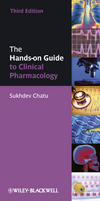The Hands-on Guide to Clinical Pharmacology, 3rd EditionISBN: 978-1-4051-9195-1
Paperback
248 pages
August 2010, Wiley-Blackwell
 |
||||||
Since the publication of the Oxford Handbook of Clinical Medicine in 1985, a plethora of similar pocket-sized guides to a wide variety of medical specialities has appeared in the white coats of both medical students and junior doctors. The popularity of these books can be attributed to the concise and well-structured ‘page per topic’ format introduced by the original handbook and employed almost universally by subsequent authors. This slim volume applies the same successful formula to the subject of Clinical Pharmacology, aiming to provide a concise source of relevant information on commonly used drugs. The authors (themselves medical undergraduates) have written their book as both a revision guide for medical students and as an aide-memoire for junior doctors, but have they been successful?
The book certainly passes the first test, fitting easily into a white coat pocket. Approximately 100 drugs are described, grouped into chapters by organ system in a similar fashion to the British National Formulary. One page is devoted to each drug, the information presented in consistent tabular format. Indications, mechanism of action, adverse effects, contra–indications and interactions are listed, although drug doses have not been included. The authors have coped well with the limitation of space imposed by the ‘pocket’ format, including only the most clinically relevant information. Although most major drug classes are dealt with in adequate depth, future editions may need to find room for pages describing the newer anticonvulsants and antiplatelet agents. Some extra space could be found with the omission of the guides to management of common conditions, which have been presented at the beginning of each chapter in heavily truncated bullet point format. These are too brief to be of practical use and are much better addressed by the more general medical handbooks.
The Hands-on Guide to Clinical Pharmacology will prove popular among medical students as it provides answers to commonly asked questions in a format that is concise and easy to use. The omission of drug doses renders it rather less attractive to junior medical staff whom I suspect will continue to rely upon the British National Formulary. (British Journal of Clinical Pharmacology)



